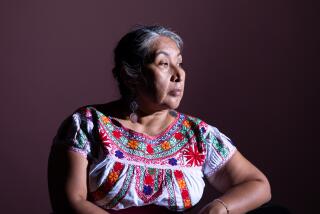MELTING POT : Native Tongue
Outdoors it is quiet--the way a suburban neighborhood can be only when the kids are in school. In a modest, wood-framed Escondido home, a woman is speaking what sounds like a foreign language, one full of clicks and softly tongued words. But it is native to the area--Native American.
The woman is Villiana C. Hyde, 90, and the language is Luiseno, spoken by no more than 30 of the 3,000 remaining Luiseno people. Listening intently is Mark Macarro, manager of library and museum services of the Rincon Indian Reservation, one of six Luiseno reservations in a wedge-shaped area that stretches some 20 miles north of nearby Valley Center. He takes notes on what she says, sometimes recording it. Whenever he hears an unfamiliar word, he asks her to repeat it. In turn, she encourages him to repeat the word aloud--over and over--until he gets the pronunciation just right.
And that’s no mean feat, even for Macarro, 29, who himself is Luiseno. The language has sounds that are difficult for English speakers to repeat. It has no “g” sound, for example, but rather an “ng” with a nasal inflection.
For Hyde, the process of reviving her language began in the 1960s, when she joined linguists at UC San Diego to develop a phonetic guide to Luiseno, which subsequently led to a book, “An Introduction to the Luiseno Language.”
Hyde speaks Luiseno proudly, but she can still remember her early childhood at the Rincon Reservation School where, she says, “the teachers would hit you if you didn’t talk English all the time.”
Hyde is encouraged that Macarro is passing on the language to younger Indians and teaching them traditional Luiseno songs. “I can only hope that after I die,” she says, “there will still be people like Mark to keep this language alive.”
More to Read
Sign up for Essential California
The most important California stories and recommendations in your inbox every morning.
You may occasionally receive promotional content from the Los Angeles Times.










